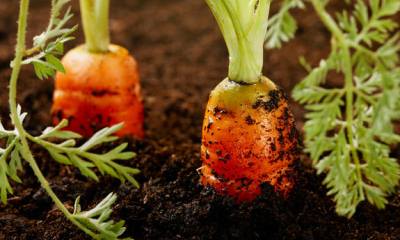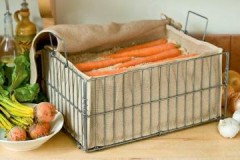Effective ways to keep carrots in the ground until spring
 Proper storage of the carrot crop is a difficult problem for gardeners. It is especially acute in the absence of basements and cellars.
Proper storage of the carrot crop is a difficult problem for gardeners. It is especially acute in the absence of basements and cellars.
One way to address the issue is to keep the carrots in the ground until spring. With proper organization, root crops can easily survive even severe frosts.
Let's analyze in more detail, how to properly preserve carrots in the ground until spring.
Content
Root storage: myth or reality?
It is quite possible to preserve a vegetable throughout the winter if the appropriate conditions are created for this - so that the vegetables do not deteriorate and do not lose their taste.
Storage conditions carrots:
- humidity - about 95%;
- temperature - about 0 ° C.
In addition to observing external conditions, requirements are also imposed on the vegetable itself:
- late-ripening variety;
- reaching full maturation;
- lack of physical damage and illness.
The vegetable itself has a thin peel that is susceptible to external influences. If the storage organization technology is violated, root crops begin to lose natural moisture and deteriorate.
Variety selection and preparation features
Not all varieties are suitable for storage in the ground, but only late ripening, including hybrid ones. They must be adapted to climatic conditions and have good cold resistance.
 The most popular among them are:
The most popular among them are:
- Shantane;
- "Incomparable";
- Royal Shantane;
- Perfection;
- Sirkana F1 and others.
The choice of seeds for carrots, which are intended for storage in the ground, should take into account the characteristics of the growing area.
Even at the stage of choosing a place for a garden bed and seeds, it should be taken into account that the crop will remain in the ground for the whole winter. Requirements for the site:
- The territory should not be in a zone of flooding by water (ground or as a result of heavy rainfall).
- Rodent protection required.
- The shelter must be secure enough to prevent the soil from freezing.
- The soil should not be infested with pests.
- The area for carrots should not interfere with the spring sowing work.
There are 2 ways to save carrots in the ground without using a special room:
- Directly in the garden.
- In a hole in the ground.
Each of the options presented has its pluses and minuses.
How to properly store the crop in the garden?
Since carrots are resistant to low temperatures, they can be left directly in the garden on which they grew. In winter, severe frosts are possible, so it is better to organize additional shelter.
This method is acceptable under the following conditions:
- no time to harvest;
- no storage conditions - no cellar or other suitable room.
 Disadvantages of storing vegetables in the ground unharvested:
Disadvantages of storing vegetables in the ground unharvested:
- possible damage to root crops by rodents;
- there is a possibility of damage to the crop by pests remaining in the soil;
- there is no certainty that all the vegetables left in the beds are of good quality, since it is impossible to inspect them before storage;
- in very snowy winters, it can be difficult to reach carrots.
To create a shelter right on the garden bed you will need:
- black polyethylene;
- roofing material;
- boards or sand.
Procedure:
- Remove weeds from the carrot bed.
- If the tops remain green until late autumn, they need to be cut off. The tail that remains should be no more than 20-30 mm.
- Place a row of planks on top or sprinkle wet sand in a layer of 20-30 mm.
- If the option with sand is chosen, then a layer of black polyethylene is placed on top of it before the onset of frost.
- Pour a layer of mulch.
- Covering with a layer of film and roofing material for protection from low temperatures.
We leave for the winter in a pit
The method of storing carrots in an earthen pit involves preliminary digging out of the crop. This option for preserving root crops can be adopted in the absence of storage space.
For extracting carrots you will need such tools:
- pitchfork;
- sharp knife.
The use of a shovel is not advisable, as this increases the likelihood of damage to the tubers.
The order of work on harvesting:
 Using a pitchfork, dig out the carrots as carefully as possible.
Using a pitchfork, dig out the carrots as carefully as possible.- Dry the carrots.
- After drying, sort the carrots. Only large and even ones will be stored.
- Cut off the tops with a knife, leaving no more than 30 mm.
- Folding into bags. This item is optional if storage in bulk is expected.
In the process of digging up the harvest, a rough mechanical effect on root crops should be excluded, since even minor damage can negatively affect the quality of preserving the harvest.
After the carrots are prepared, you need to take care of creating an earthen hole. To carry out the work you will need:
- shovel;
- sand (coarse) or straw;
- boards;
- slate;
- rodent net.
The order of work:
- A hole is being dug. Its depth is determined by climatic conditions. For severe frosty winters - 100 cm, for not severe - 50 cm. The width should be about 50 cm. The length is determined by the volume of the harvested crop.
- Cover the bottom of the pit with wet sand. In its absence, you can use hay. The main requirement when creating such a "pillow" is to avoid contact between carrots and soil.
- Laying of a mesh with fine mesh for protection from rodents.
- Cover the walls of the trench with boards.
- Carrots bookmark. Sprinkle the layers with straw or sand. In this case, there should be a gap of about 20 cm from the soil surface.
- Pour a layer of earth on the last layer of sand or straw.
- Add mulch or pine needles to create insulation.
- Apply slate.
- Dig a shallow trench around the storage facility to drain water.
Duration
The shelf life of vegetables depends on compliance with all conditions.Subject to all the rules, root crops are well preserved until warm spring days.
 The following factors can affect the reduction in duration:
The following factors can affect the reduction in duration:
- access to rodent food;
- flooding;
- poorly organized shelter, as a result of which vegetables freeze;
- soil contamination with pests.
Vegetables dug from an earthen hole or garden beds are not stored outdoors for a long time. In this regard, it makes sense to get carrots no more than necessary. In the second year, these vegetables begin to lose their taste.
Recommendations
Simple tips will help you avoid common mistakes and save your harvest:
- When leaving carrots in the winter in the garden, the tops should not only be cut off, but also removed from the garden. If left, root crops may rot.
- As mulch for insulation can be used: straw, sawdust, hay, etc.
- The smell of pine needles can scare off annoying rodents, so it is advisable to spread coniferous paws around the perimeter around the store.
- The presence of sand in the soil helps to better preserve the crop. Sand also prevents the development of dangerous diseases leading to decay.
- Carbon dioxide emitted by carrots during storage contributes to better storage of vegetables.
Useful video
A method of storing carrots in the ground until spring is presented in the video:
Conclusion
Storing carrots in the ground is a fairly effective way to preserve the harvest. They are quite simple, but effective. With the right arrangement, you can see fresh crispy carrots on your table even in spring.



